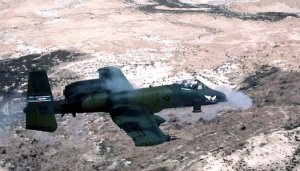
A-10-G

Mission
The A-10 and OA-10 Thunderbolt IIs are the first Air Force aircraft specially designed for close air support of ground forces. They are simple, effective and survivable twin-engine jet aircraft that can be used against all ground targets, including tanks and other armored vehicles.
Features
The A-10 / OA-10 have excellent maneuverability at low air speeds and altitude, and are highly accurate weapons -delivery platforms. They can loiter near battle areas for extended periods of time and operate under 1,000-foot ceilings (303.3 meters) with 1.5-mile (2.4 kilometers) visibility. Their wide combat radius and short takeoff and landing capability permit operations in and out of locations near front lines. Using night vision goggles, A-10 / OA-10 pilots can conduct their missions during darkness.
Thunderbolt IIs have Night Vision Imaging Systems (NVIS), compatible single-seat cockpits forward of their wings and a large bubble canopy which provides pilots all-around vision. The pilots are encircled by titanium armor that also protects parts of the flight-control system. The redundant primary structural sections allow the aircraft to enjoy better survivability during close air support than did previous aircraft. The aircraft can survive direct hits from armor-piercing and high-explosive projectiles up to 23mm. Their self-sealing fuel cells are protected by internal and external foam. Their redundant hydraulic flight-control systems are backed up by manual systems. This permits pilots to fly and land when hydraulic power is lost.
The Thunderbolt II can be serviced and operated from bases with limited facilities near battle areas. Many of the aircraft's parts are interchangeable left and right, including the engines, main landing gear and vertical stabilizers.
Avionics equipment includes communications, inertial navigation systems, fire control and weapons delivery systems, target penetration aids and night vision goggles. Their weapons delivery systems include head-up displays that indicate airspeed, altitude and dive angle on the windscreen, a low altitude safety and targeting enhancement system (LASTE) which provides constantly computing impact point freefall ordnance delivery; and Pave Penny laser-tracking pods under the fuselage. The aircraft also have armament control panels, and infrared and electronic countermeasures to handle surface-to-air-missile threats.
The Thunderbolt II's 30mm GAU-8/A Gatling gun can fire 3,900 rounds a minute and can defeat an array of
ground targets to include tanks. Some of their other equipment includes an inertial navigation system, electronic
countermeasures, target penetration aids, self-protection systems, and AGM-65 Maverick and AIM-9 Sidewinder
missiles.
General Characteristics
Primary Function: A-10 -- close air support, OA-10 - airborne forward air control
Price: 80,000 for the refit
Crew: One
Power Plant: Two General Electric TF34-GE-100 turbofans
Thrust: 9,065 pounds each engine
Length: 53 feet, 4 inches (16.16 meters)
Height: 14 feet, 8 inches (4.42 meters)
Wingspan: 57 feet, 6 inches (17.42 meters)
Speed: 420 miles per hour (Mach 0.56)
Ceiling: 45,000 feet (13,636 meters)
Maximum Takeoff Weight: 51,000 pounds (22,950 kilograms)
Range: 800 miles (695 nautical miles)
MDC: 1000
Armament:
- One 30 mm GAU-8/A seven-barrel Gatling gun; MDC DU rounds: 100 round burst 5D6x20 (I know this figure sounds high but it is known as the tank killer)
- Up to 16,000 pounds (7,200 kilograms) of mixed ordnance on eight under-wing and three under-fuselage pylon stations, including 500 pounds (225 kilograms) of retarded bombs, 2,000 pounds (900 kilograms) of general-purpose bombs, incendiary and Rockeye II cluster bombs, combined effects munitions, Maverick missiles and laser-guided/electro-optically guided bombs
- 2.75-inch (6.99 centimeters) rockets; HE 6D6, Frag 5D6, AP 2D4x10
- Sidewinder missiles; 2D6x10
infrared countermeasure flares;
electronic countermeasure chaff;
jammer pods;
illumination flares
